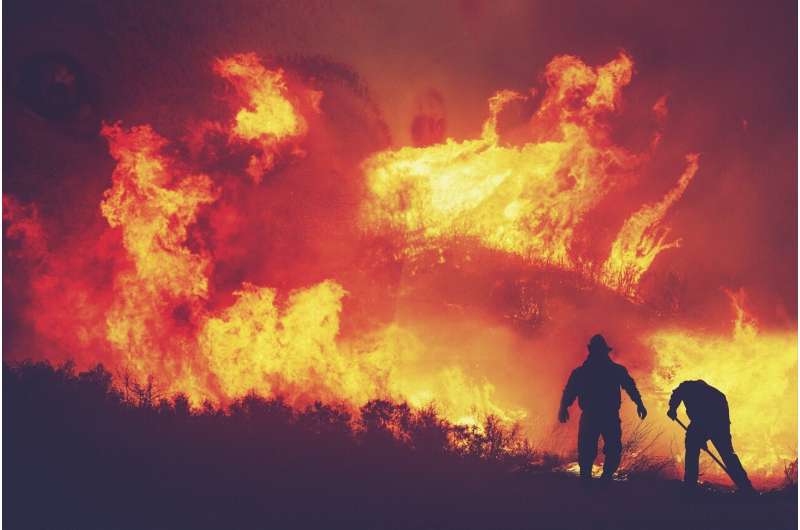Firefighter exposure to wildfire smoke compounds varies depending on duties

Every summer, wildfires rage across the western U.S., and wildland firefighters are tasked with putting them out. But in the process, they inhale smoke and all the compounds in it, which can be harmful at high amounts. Now, researchers reporting in ACS' Environmental Science & Technology have evaluated the presence of particulate matter and volatile organic compounds (VOCs) around firefighters actively combating blazes, finding the highest exposures among hotshot crews and those creating firebreaks.
Most images of wildland firefighters show them covered from head to toe in black soot, or particulate matter, which they're breathing in along with a mixture of other compounds in smoke. Inhaling particulate matter is associated with respiratory problems, such as asthma and chronic obstructive pulmonary disease, and researchers suspect that VOCs in wildfire smoke could exacerbate these conditions. However, getting accurate estimates of firefighters' exposures to these pollutants is tough because of the extreme work environment, the different crew types and the variety of fire suppression tasks. For example, elite hotshot crews are on the front lines battling the hottest zones, while other crews may perform tasks in less intense parts of the fire's edge or use long hoses to deliver water and foam, usually to remote areas. So, Kathleen Navarro and colleagues wanted to evaluate particulate matter and VOC exposures of different types of firefighters.
The researchers attached air samplers to wildland firefighters' equipment, which they used when responding to large fires in many locations across the western U.S. Then the team measured the amount of particulate matter collected over one shift, averaging 14 hours, and used that data to estimate exposures to three potentially hazardous VOCs—acrolein, benzene and formaldehyde. Their results showed the single-shift exposures to these substances were below Occupational Safety and Health Administration limits for all subjects. However, the amounts of particulate matter and formaldehyde were above the shift-averaged recommendations of the National Wildfire Coordinating Group and National Institute for Occupational Safety and Health for some of the firefighters. Hotshot crews, firefighters creating firebreaks (wide gaps in vegetation to stop the fire's expansion) and personnel battling blazes in the Pacific Northwest were exposed to the highest amounts of the pollutants. Finally, the team asked the participants to qualitatively assess their smoke exposure, finding the responses aligned with the measured particulate matter exposures. To protect wildland firefighters' health, the researchers suggest that fire management should work on reducing smoke exposures of firefighters, whenever possible. This could include incorporating self-reporting of exposure and rotate personnel from tasks that regularly experience high exposures to smoke and its pollutants to less smoky ones.
More information: Kathleen M. Navarro et al, Exposure to Particulate Matter and Estimation of Volatile Organic Compounds across Wildland Firefighter Job Tasks, Environmental Science & Technology (2021). DOI: 10.1021/acs.est.1c00847
Journal information: Environmental Science & Technology
Provided by American Chemical Society




















